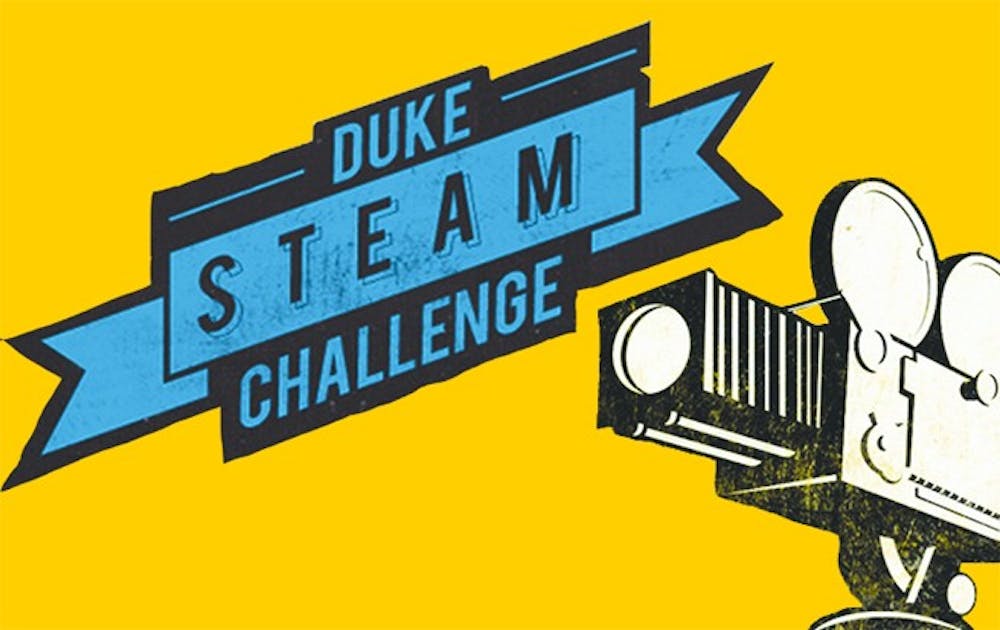A newly developed competition set to launch this week will help Duke bridge the gap between the sciences and the humanities.
The Duke STEAM Challenge, which will run from orientation week to January 2014, is organized by the Humanities, Arts, Science, and Technology Alliance and Collaboratory, an organization committed to thinking about intersections between these two academic spaces. The competition seeks to provide students with the chance to work in teams to identify and solve real world problems by exploring ways in which the science, technology, engineering and math disciplines can work synergistically with the arts and social sciences.
“The Duke STEAM Challenge is the first student challenge designed to integrate knowledge from many fields, and to show how much we need contributions across disciplines for true innovation and transformations,” said Cathy Davidson, a co-organizer of the challenge and Ruth F. Devarney professor of english.
The challenge will launch on the coattails of President Brodhead’s guest appearance on The Colbert Report, where he emphasized the importance of the arts and gave the humanities the “Colbert Bump”.
“As our president said on the show, in today’s world, the leaders are going to be those who not only have backgrounds in STEM or the humanities, but those who can contribute to the intersection between those areas,” said co-organizer Keith Whitfield, the vice provost for academic affairs and professor of psychology and neuroscience.
The STEAM challenge is project based, and students will work in teams of two to five to find and address a real world problem using STEAM principles. The competition is open to any and all Duke students – undergraduate, graduate and professional students, and cross-class collaboration is encouraged although not required. What is required, however, is that each team be interdisciplinary in nature in terms of profession, majors, or interests. Teams are expected to submit team profiles outlining each members’ background to help with this process.
“We want to find things like artists working with engineers, because that kind of collaboration is how the real world works,” said Mandy Dailey, director of administration for HASTAC. “Even for freshmen who haven’t declared a major yet, we’d like to know where their interests lie.”
The challenge was announced in two parts, with the first, the Duke STEAMy Summer Challenge, running through the summer. Students were asked to make a two minute video describing why the values of STEAM are important and what those values mean to them. Of the many submissions, five finalists have been selected, and the winner of the $1000 prize for this challenge will be announced in the near future.
“A few times last week, I checked in on the Duke STEAM Challenge Facebook page,” said junior Kate Bulger, an intern for the program, in an email Friday. “It felt great seeing an almost constant stream of notifications of “likes” for the videos – likes from across the community, including from Steve Nowicki.”
Bulger added that the STEAMy Summer Challenge really helped raise awareness for the bigger STEAM Challenge that will launch this week.
Teams will submit their problems and proposed solutions by October, and the most compelling projects as selected by a panel of judges will further develop their pitches over the fall and winter, ultimately presenting live in January, when a winner will be selected. The grand prize for this portion of the competition will be $10,000, with second and third place winning $3,000 and $2,000, respectively.
Although the competition will require all teams to pay for any project expenses out-of-pocket, Dailey expects that pitches will span the spectrum from hypothetical to truly applied, all of which is acceptable as long as it addresses the identified problem in an interdisciplinary way.
“This is going to be a great thing to have on your resume,” she said. “Freshmen who choose to throw themselves into [the STEAM Challenge] will learn to work collaboratively, meet like-minded folk and discover the different ways to share the resources that we have at Duke.”
Ultimately, the staff of the Duke STEAM Challenge has high expectations for the benefit that the program can provide for the academic culture at Duke. Though the challenge hits some of the same chords as other team project-based challenges such as the Duke Startup Challenge, the emphasis on interdisciplinary principles sets STEAM apart.
“STEAM is unique in that it’s not asking students to create widget or a product for the sake of business,” said Whitfield. “It’s much more directly related to their education and we’re really asking them to think about how the Duke education they’re receiving makes sense in a broader context.”
Get The Chronicle straight to your inbox
Signup for our weekly newsletter. Cancel at any time.

